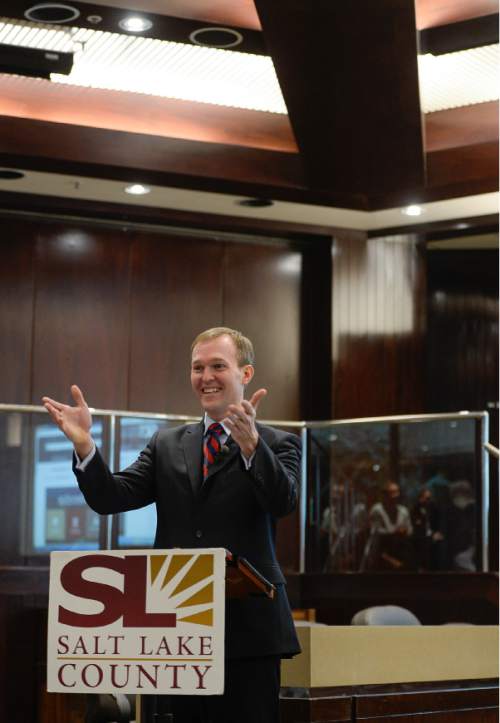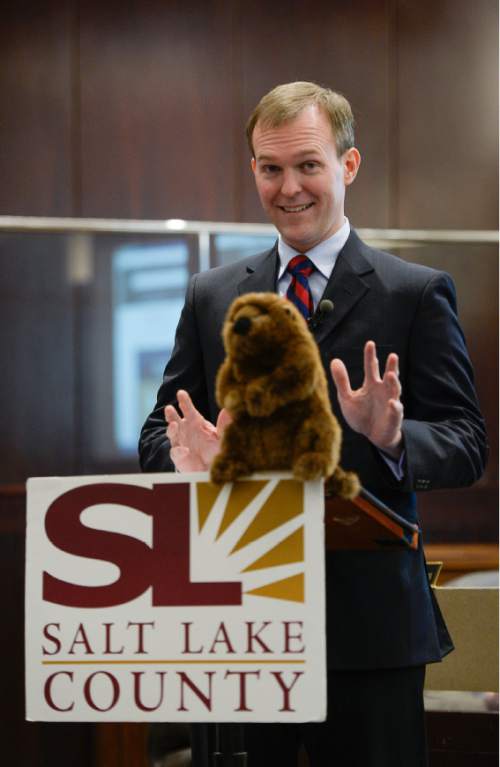This is an archived article that was published on sltrib.com in 2016, and information in the article may be outdated. It is provided only for personal research purposes and may not be reprinted.
Coming off a year of numerous accomplishments, Salt Lake County is committed to working even harder in 2016 to build "a Greater Salt Lake through healthy people, healthy places, expanded opportunities and responsive government."
That ongoing effort, Mayor Ben McAdams said in his State of the County speech Tuesday, will begin with a fundamental public-safety issue critical to saving lives — the long-awaited development of a single, centralized 911 dispatch system.
"The future we choose," McAdams said, emphasizing his administration's working theme, "is one where lifesaving services matter and long-running turf battles are overcome."
Public-safety agencies have been working for two years, supported by $1.4 million in funding from the county, to move from two dispatch systems to one, hoping to avoid delays in emergency response due to 911 calls being routed to the wrong agency.
Salt Lake City, Sandy and the Unified Police Department use one system, which in 2014 handled about 70 percent of emergency calls.
The rest went through the Valley Emergency Communications Center, which dispatches for seven valley cities — West Valley City being the largest — and seven fire departments, including the Unified Fire Authority.
McAdams said an agreement has been reached to go forward with one system, without identifying who was selected. It will be implemented during the next 18 months.
As he has done throughout his mayoral tenure, McAdams also spoke repeatedly about the need for good data to measure the effectiveness of existing programs and determine future approaches.
He said such stats will be an important component of the Pay for Success programs the county will initiate this year to attack jail recidivism and homelessness, but will apply to evaluations of programs across the board.
"The consequences of failing to measure the impact of our policies and programs go well beyond wasting scarce tax dollars," the first-term Democratic mayor said. "Every time a child or a teenager or a homeless veteran participates in a program that doesn't work — but could have participated in one that does — that represents a human cost."
To help county agencies and the public know how programs are faring, McAdams said a "dashboard" — called Salt Lake MetroStat — was being launched Tuesday on the county website, https://dashboard.slco.org.
"It's loaded with information, goals and performance metrics for what our customers want to know and deserve to know," he said. "Are the roads maintained? Is air quality improving? Is the crime rate going down? Are our buildings serving their public purpose?"
In terms of the last question, McAdams said he was launching an audit of county facilities to develop an index to gauge where maintenance dollars are needed most and to set up a systematic approach to keeping them shipshape.
The dashboard's reach even will extend to potholes, a problem that challenges the county, the mayor acknowledged. While 53 percent of county roads now are deemed "acceptable," McAdams said only $2.3 million is going into maintenance this year when closer to $7.5 million is needed.
He also pledged to come out in March with a data-driven plan, as part of the county's participation in the Global Cities Initiative, to help businesses improve prospects for exporting goods or services to other countries.
Much of the year's focus will be to advance projects that moved forward in 2015, McAdams said, citing:
• Dealing with homelessness.
• Criminal-justice reform.
• The Community Preservation process that produced the soon-to-be Millcreek City, five metro townships and the Greater Salt Lake Municipal Services district for the unincorporated county.
• Community improvements in Kearns.
• Improving air quality.
• Possible solutions to issues in the canyons through the Mountain Accord, the new Mountainous Planning District and ongoing revisions to the county's FCOZ (Foothills and Canyons Overlay Zone) ordinance.
• Construction of a headquarters for the district attorney and several health department buildings.
McAdams took several opportunities to thank individual council and staff members for their support. He also praised the efforts of residents such as Bryce Seipert of Kearns and eBay seller Mac Griffiths to make Salt Lake County a better place.
County Council Chairman Max Burdick, a Republican, said the Democratic mayor's frequent expressions of gratitude for others' contributions exemplified why the county is better off than many communities.
"It's impressive that he's not just trying to keep all the credit to himself," Burdick said, "and that shows a collaborative effort that's helped us get things done. For the last three years, the council and the mayor's offices have worked closely together and the mayor has done a good job of coming to the council and explaining his thoughts, ideas and programs."
For that reason, little of what the mayor had to say Tuesday was new to Burdick — except that a 911 agreement had been reached.
"That's huge," he said. "It's gone on and on for so long. To get [a single dispatch system] up and going will just be so important."
In the end, McAdams said, "our future looks promising. I'm eager to roll up my sleeves and do even more to make our [community] strong, safe, vibrant, diverse and healthy."
Other 2016 goals
Much of Salt Lake County Mayor Ben McAdams' focus this year will be to advance projects that moved forward in 2015, including:
• Dealing with homelessness.
• Criminal-justice reform.
• The Community Preservation process that produced the soon-to-be Millcreek City, five metro townships and the Greater Salt Lake Municipal Services district for the unincorporated county.
• Community improvements in Kearns.
• Improving air quality.
• Possible solutions to issues in the canyons through the Mountain Accord, the new Mountainous Planning District and ongoing revisions to the county's FCOZ (Foothills and Canyons Overlay Zone) ordinance.
• Construction of a headquarters for the district attorney and several health department buildings.
Mike Gorrell

















